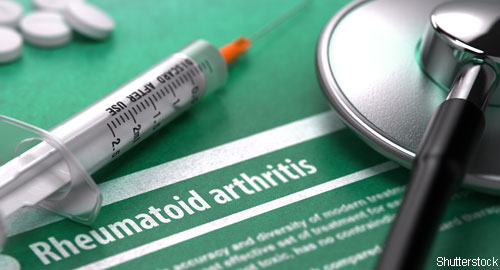Stati ns inhibit hydroxymethylglutaryl-coenzyme A (HMG-CoA) reductase and reduce cholesterol levels. They also influence many other aspects of cellular physiology. A recent study has described an effect that is of particular interest to rheumatologists: High-intensity statin therapy is associated with a 23% reduced risk of rheumatoid arthritis (RA) relative to low-intensity statin treatment. The investigators describe this effect as equivalent to preventing 11 out of 150 high-risk patients from developing arthritis over a two-year period. Koray Tascilar, MD, visiting scientist at the Lady Davis Institute for Medical Research in Montreal, and colleagues published the results of their nested case-control study in the November 2016 issue of Arthritis & Rheumatology.1
ns inhibit hydroxymethylglutaryl-coenzyme A (HMG-CoA) reductase and reduce cholesterol levels. They also influence many other aspects of cellular physiology. A recent study has described an effect that is of particular interest to rheumatologists: High-intensity statin therapy is associated with a 23% reduced risk of rheumatoid arthritis (RA) relative to low-intensity statin treatment. The investigators describe this effect as equivalent to preventing 11 out of 150 high-risk patients from developing arthritis over a two-year period. Koray Tascilar, MD, visiting scientist at the Lady Davis Institute for Medical Research in Montreal, and colleagues published the results of their nested case-control study in the November 2016 issue of Arthritis & Rheumatology.1
“We analyzed a cohort of more than half a million new statin users from a large population-based primary care database, with data on exposure and covariates collected prospectively and independently of the outcome measure, in a real-life setting,” write the authors in their discussion. “In addition to detailed prescription information, the CPRD [UK Clinical Practice Research Datalink] includes data on smoking status and body habitus, thereby allowing adjustments that were not possible in some previous studies.
“Employing a new-user design, an active comparator instead of a user vs. nonuser or adherer vs. nonadherer comparison, and a time-dependent exposure definition allowed us to minimize the risks of confounding by indication, healthy-adherer bias and time-related biases.”
The investigators identified 1,357 new cases of RA that occurred in the statin-user population during a mean follow-up of 3.3 years. This translated into an RA incidence of 7.9 per 10,000 person-years in the statin-user population. The investigators then matched these new RA cases to 13,570 controls and found the mean duration of statin use was similar among cases and controls. The patients who developed RA, however, tended to be smokers, have other autoimmune diseases and have lower total cholesterol levels at baseline.
The researchers next calculated statin exposure using duration-weighted average statin intensity. They found a protective effect in the top quintile of statin exposure relative to the bottom quintile of statin exposure. The protective dosages were 20–80 mg atorvastatin, 5–40 mg rosuvastatin or 80 mg simvastatin. The researchers noted that these doses were calculated based on prescription records and not actual receipt of the medication from a pharmacy. The protective effect of the statins appeared to be most prominent between six and 12 months after initiation of statin therapy and gradually decreased after one year.
“Although this paper is rather exciting, it remains observational and subject to inherent limitations of this type of study design,” explains co-author Marie Hudson, MD, MPH, a rheumatologist at the Jewish Hospital and Lady David Research Institute, in an email to The Rheumatologist. “It requires confirmation in a randomized, controlled trial. Nevertheless, in the meantime, we now have the interest and tools to identify individuals at high risk of RA.”
